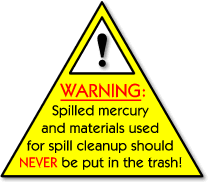 |
| MERC home > proper disposal > spill cleanup procedure |
Cleanup Instructions for Small Mercury Spills - FACT SHEET: Mercury SpillsFor information on broken fluorescent light bulbs see- FACT SHEET: Compact Fluorescent Light Bulbs
Take Immediate PrecautionsDo not touch the mercury. Keep pets, children (especially infants and young children) and pregnant women out of the room. Do not walk on the mercury or track it into other areas of the house. Open windows to ventilate the area. Close off the room from other rooms in your house. Shut the door and close any air pathways (like floor or ceiling grates, air conditioning or heating vents) which will circulate mercury vapors into other areas of the house. Can I clean up a small spill in my own home? You can probably clean up a small spill by yourself if the following is true:
Large SpillsIf the spill involves a large area, has been spread around, is in cracks and crevices or other difficult to clean places, or is on non-disposable porous items such as wall-to-wall carpeting or upholstery follow steps below "On a hard surface" then call the emergency spill response program at the Vermont Department of Environmental Conservation's Waste Management Division at 802-241-3888 during normal working hours or by calling the 24-hour emergency number at 800-641-5005. Contain the SpillSpilled mercury can spread quickly. Move furniture and other objects away from the spill and prevent the mercury from flowing into drains, cracks or crevices. The mercury that remains in cracks, crevices or drains will continue to emit dangerous vapors so it is important to contain every drop. Never Vacuum or Sweep Up the Spilled MercuryVacuuming or sweeping up a mercury spill will spread the mercury throughout the house and contaminate your vacuum or broom. This will result in a release of mercury every time you use your vacuum or broom in the future. Clean the SpillFollow the cleanup procedure below. For more information see - FACT SHEET: Mercury Spills On a hard surface, wear disposable gloves if at all possible. Use stiff cardboard (such as playing cards or index cards) to push mercury droplets together and to scoop up beads of mercury; a flashlight will reflect off of shiny mercury beads and make them easier to see. Use the sticky side of duct or masking tape to pick up any remaining mercury beads. Dispose of the Mercury Waste Responsibly
|
|
|
||||||||
|
MERC Home | mercury
facts | mercury in fish
| environmental concerns |
statutes & regulations | mercury-added
product manufacturer requirements Mercury Education & Reduction Campaign |


 Place the mercury-contaminated cleanup materials (cardboard, gloves, tape, etc.) into double plastic bags or preferably a glass or rigid container with a lid for containment. In the meantime, store the bag or container (label and separate from your regular trash) - outside the house in an area inaccessible to children. Never put the mercury waste in the trash! Contact your
Place the mercury-contaminated cleanup materials (cardboard, gloves, tape, etc.) into double plastic bags or preferably a glass or rigid container with a lid for containment. In the meantime, store the bag or container (label and separate from your regular trash) - outside the house in an area inaccessible to children. Never put the mercury waste in the trash! Contact your